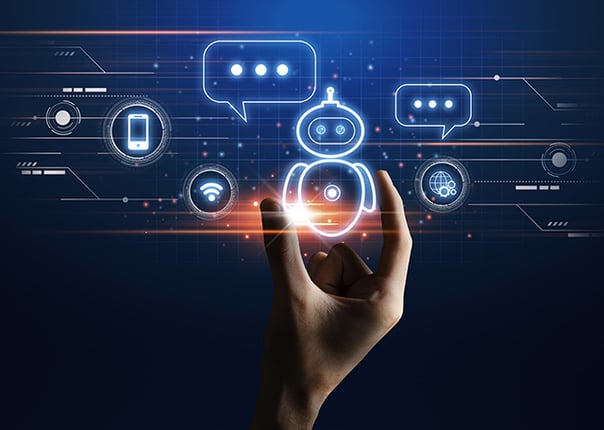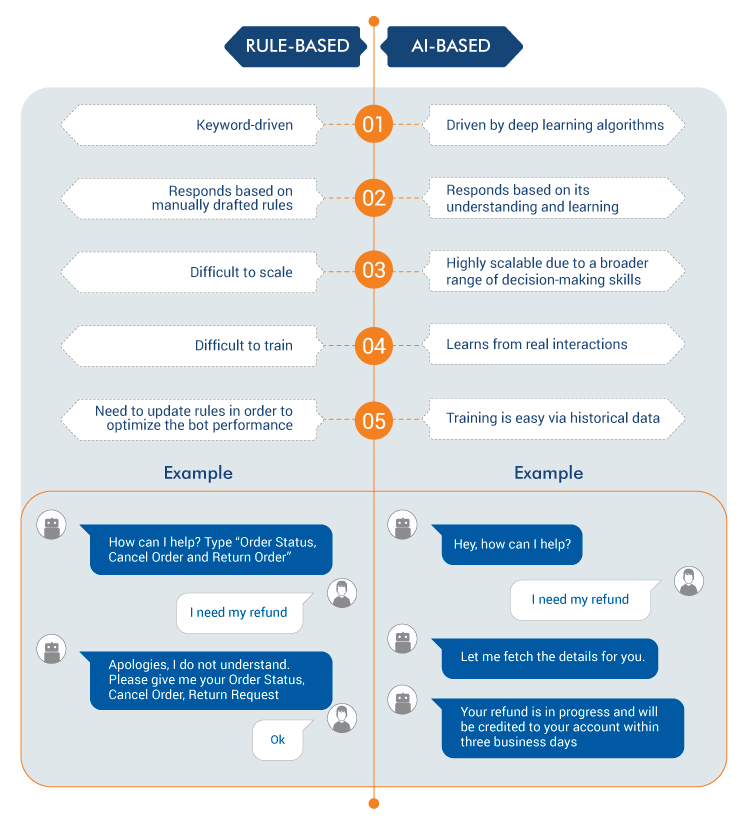
A chatbot powered by an artificial intelligence (AI) program acts as a conversation agent for your business. It simulates the chat or conversation with a user in natural language via mobile applications, messengers, or websites.
There is no denying the fact that AI-powered chatbots have become an integral part of online businesses as they let you do what was once impossible - help customers 24/7, resolve queries without any human intervention, and support multiple customers at once. A few other key benefits that chatbots offer to businesses include:
A report by SurveyMonkey reveals that chatbots will continue to evolve with consistent evaluation and optimization.
- High-speed resolution to queries
- Reduced operational costs
- Multilingual support
- Data collection opportunities
- Less interactive voice response (IVR) frustrations
Chatbot Technology Trends
- Personalization: Involves training the chatbot with customer profiles and behavior. An AI powered bot can suggest products or brands preferred by customers.
- MLOps (Machine Learning Operations): Many organizations use a CRM to store and manage their customer’s details. When integrated with chatbots, CRMs provide information to chatbots so that they can check specific user details from their previous conversations. Chatbots also feed information to the CRM so company and individual profiles can be updated.
- Voice Recognition: Enables faster user interactions which are also hands-free. Siri, Alexa, and Google Nest are all great examples of applications that use voice recognition.
Chatbots can be categorized into two areas, rule-based and self-learning bots. Bots that answer questions based on the rules that they are trained on are called rule-based chatbots. These rules can vary from simple to complex, but they can be very time-consuming to outline and write. Rule-based chatbots also have lower ceilings as it is virtually impossible to cover every possible case.
On the other hand, bots that use machine learning techniques to handle user queries are called self-learning, or artificial intelligence-based chatbots. These bots imitate human responses to each query and respond to each question by learning natural-language responses through the machine learning engine.
Difference Between Rule-Based and AI-Based Chatbots

Advantages of Rule-Based Chatbots
- Accountable and Secure: Rule-based chatbots respond to a user’s query based on predefined rules and scripts. This makes rule-based chatbots more accountable and secure as they cannot self-learn, which ensures they offer consistent customer service.
- Not Restricted to Text Interactions: The more you program and optimize your rule-based chatbot algorithm, the better it will respond. Rule-based chatbots are not restricted to text interactions only. You can always define a new set of rules to make them more versatile.
- Less Expensive: They perform and work on the scenarios that they are trained for, which makes rule-based chatbots typically faster to create and less expensive to maintain.
- Easy Integration With Legacy Systems: Rule-based chatbots are easy to integrate with systems with older configurations, which means teams don't have to spend any extra on upgrading or purchasing new hardware or software.
Advantages of AI-Based Chatbots
- Continuous Improvement Based on Incoming Data: AI chatbots use incoming chat data to analyze and prepare adequate responses. The more that data is analyzed, the better their performance will be. AI chatbots generate answers to complicated questions by understanding the intent of a question and then formulate a response using natural language.
- Understand Multiple Languages: AI chatbots are not restricted to a particular language. They can be programmed for multiple languages and can respond to users' queries in a wide range of languages.
- More Efficient Than Rule-based Chatbots: Compared to rule-based chatbots, AI chatbots are more efficient and can make better responses by analyzing user behavior. While in the case of rule-based chatbots, you have to train them yourself by defining new rules every time your query comes in.
Examples of Industries Utilizing Chatbots
- Supply Chain and Logistics: Chatbots are used for keeping track of the inventory levels in supply chain operations. Common examples are shipment tracking, change requests, finding solutions to general inquiries, and getting delivery notifications.
- Travel and Tourism: Chatbots have made ticket booking much faster and can even provide recommendations to a user based on their activities on the website. For example, on flight booking sites, chatbots help visitors search for flights by analyzing their previous flight booking patterns and recommending flights that fit their budget and time.
- eCommerce: Businesses like Amazon and eBay use chatbots to give recommendations to the users related to their search history and assist them in finding the desired products.
Benefits of Chatbots
- 24/7 Availability: Customers expect business to be available 24/7. Chatbots make it easy to maintain an around-the-clock response system, assuring continuous communication between customers and sellers.
- Automates Your Work: Automating your customer support work by introducing chatbots will work in your business favor. They can handle multiple users at a time and will answer their queries automatically, so your team can focus on other important projects. It will also improve the customer support quality, allowing customers to trust in your service level.
- Reduces Human Errors: The smart algorithms along with programming allow chatbots to be consistent and remain error-free. Chatbots never forget anything and shouldn't make errors, which can not be said when people are answering each question.
- Learning and Updating: One of the biggest advantages of chatbots is that you can train and update them over time. Upgrading the algorithm along with more interactions with users allows chatbots to create new ideas to answer the queries, which improves the efficiency of the chatbots and makes them more reliable.
- Managing Multiple Users at a Time: While a human customer support agent can handle one user at a time, chatbots can manage multiple users at the same time. They are not restricted to human boundaries and can work 24/7 unless there’s any technical issue.
- Customer Support: Many companies embed chatbots in their websites to answer customer’s questions. It is one of the easiest ways to get in touch with the company's support team.
Chatbot Testing
Chatbot testing is necessary to make sure that an effective and efficient chatbot is deployed. Testing experts analyze if all the necessary features are implemented correctly or not, and make sure it can appropriately answer each user's queries.
But chatbot testing is different from traditional software testing. When testing web and mobile applications, test runs are predefined, which is not the case when testing AI-based chatbots. They are employing machine learning methods for common natural language takes, making chatbots more complex and the one-size-fits-all approach is no longer viable. So, there are chances that the predefined test runs may not work for every AI-based chatbot.
For building successful AI-based chatbots, testing phases include pre-launch and post-launch tests, which are described below:
Pre-Launch Testing
- General Testing: Testing basic questions and answers like welcome messages.
- Domain Testing: Chatbots are domain-specific and need to have specificities associated with their domain identified and tested upfront.
- Limit Testing: To check how a chatbot responds to an irrelevant question and to identify the outcome when a chatbot fails.
Post-Launch Testing
- A/B Testing: Discover the product performance by comparing two versions. Organizations can collect data and decide on which version to use.
- Conversational Factors: Validate how the chatbot will start a conversation - this can be either a standard salutation or informal responses like emojis.
- Visual Factors: Although a non-technical aspect, chatbot designs play an important role for user experience. A well-organized, user-friendly, and engaging UX in chatbot messenger can boost retention rates.
How To Test a Chatbot?
The efficiency and effectiveness of a chatbot can be verified by testing and comparing the input with the expected output. Chatbot testing is different from traditional software or mobile app testing because chatbot application algorithms are complex and deal with a wide range of user queries. Thus, a chatbot should be developed and tested considering all possible unexpected scenarios. Chatbot testing can be segregated into the below areas:
- Conversational Design Testing: Tools that understand natural language recognize input from the user, the response from the bot, and calls to external sources. It allows testers to understand the conversation overview. NLP observes the user input and intent and provides an appropriate response to the end-user.
Below are the key areas of conversation design for testing chatbot:- Conversation Flow: Test it by verifying positive scenarios, negative scenarios, expressions as approval and denial.
- Intent, Training, and Response: Intents are the purpose of the user’s input. To illustrate, below are the phrases used for training the bot:

Ideally the bot would confirm the order with the following responses:

- Casual/Small Talks: The casual conversations like greeting or welcome talks between bot and user. User experience can be improved to a great extent with such small talks.

- Fallback: This is to test the bot response from irrelevant input from the user in between a conversation.

Bots need to be trained to respond to unfamiliar inputs by writing appropriate test cases to check the fallback phase.
- Navigation: Navigational cases need to be tested in case the user wants to skip a few steps in a conversation. Chatbots need to be trained on how to handle such cases. For instance, if the order is already placed but the user wants to update or cancel it.
- Emotions: The tone of the user input like happiness, anger, sadness, fear, etc. Relevant cases should be tested to understand the emotion of input and send an appropriate response.
- Entities Testing: Entities are keywords that are taken from training phrases.

- Fulfillment Testing: The bot needs to request the information to fulfill the user request. The data is sent to the webhook to fetch the relevant information. The results are then shared with the user as a response once the fulfillment request has been completed. Integration points and data sources need to be covered in this phase.
- User Acceptance Testing: User testing is important to ensure the chatbot’s quality. Testing the chatbot with different users and different personalities can make a huge impact on the quality of the chatbot.
Chatbot Automation Testing Tools
There are many tools for chatbot automation testing. Some of the key tools are as under:
- Botium Box: This tool allows you to automate chatbot testing using APIs, and the tests will be repeated easily after every software update.
- Selenium: Selenium web driver and IDE are popularly used for chatbot testing. Chatbots can be tested using Record and Play functionality using Selenium IDE.
- Gupshup Proxy Bot: If the bot is developed using the Gupshup building platform, the same can be tested by their proxy bot. The tool allows engineers to test the bots on various communication channels like Slack, Twitter, and SMS.
- TestFairy: It will distribute the chatbot for testing and share the test reports, crash reports, and other valuable feedback with the stakeholders.
Challenges of Chatbots
- Lack of Emotions: Chatbots lack the capabilities to analyze human emotions. They can’t judge the user’s feelings such as happiness, sadness, and anger.
- Difficult to Create: The programing structure of chatbots is very complex. You should have coding knowledge to create a better-functioning chatbot.
- Sometimes, it Doesn't Understand: Users desire the best experience and their behavior is controlled by emotions. But sometimes, chatbots fail to understand what the user is trying to convey. It mainly happens when a user posts a query that is not added to the chatbot’s database yet.
The use of chatbots in businesses will continue to evolve in the coming years. If you want to adopt best practices in chatbot testing, team up with QASource’s team of testing experts. We specialize in all aspects of chatbot testing and can help your business achieve reduced time to market while ensuring accuracy and scalability. Learn more or get a free quote today.
